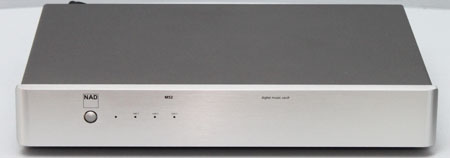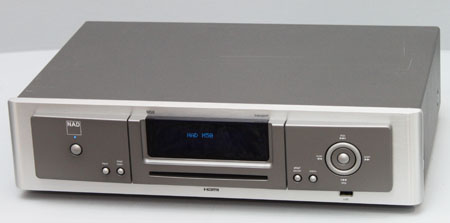NAD Masters Series launches with network players, docks and a DAC
New M50, M51 and M52 due on sale in the second half of the year – oh, and its Viso 1 all-in-one iPod dock system is now available in white


At first glance, the star product in the NAD room at the High End 2012 show here in Munich looked like the Viso 1 iPod dock system, now available in white as well as the black of our review sample of a few months back.
Surely that couldn't be it? Well, no – while the company is catering for the all-in-one market with the Viso 1, it's also taking streaming very seriously with the latest additions to its flagship Masters line-up: the M50 transport, M51 'direct digital' DAC and M52 Digital Music Vault.

All three will be in shops in Europe in the second half of the year – the DAC is just beginning to surface – and they can be used together or separately to form a variety of storage and streaming configurations.

The M52 lives up to its digital music vault description by housing hard drives in RAID 5 configuration to give 2TB of storage protected against disc failure, and when used with the M50 transport it will enable discs played on that unit to be ripped to its drives.

The M50 itself combines CD player, Ethernet streamer and USB playback hub, with the USB configuration handling both computers and portable storage devices. DAD sees this unit as being software-upgradable, which is one reason it offers audio output on optical and electrical S/PDIF, AES/EBU and HDMI connections.
NAD says it's not sure how record companies are thinking about the future of HD music, so the HDMI output is there as some future-proofing delivering – though it's not ruling out the possibility that at some point the M50 may be upgraded to play video as well as audio discs.
The unit also functions as a streaming player for on-demand services and internet radio stations, and NAD says it's investigating mechanisms by which the player will be able to be used for direct purchases of HD music downloads, without the need for a computer.
The latest hi-fi, home cinema and tech news, reviews, buying advice and deals, direct to your inbox.

The M51 DAC takes in signals at up to 24-bit/192kHz and upsamples these PCM streams to PWM at 844kHz for processing. As well as shifting any noise created in the processing way out of the audible band, this enables the DAC's digital volume control to operate across a wide rate without affecting even high-resolution signals.
NAD points out that the conversion from PCM to PWM also has the effect of removing any jitter, while the exceptionally high clock speed makes the signal free from digital artefacts such as ringing.
The M51 has conventional S/PDIF optical and electrical, AES/EBU and USB connectivity, and also had two HDMI inputs plus a video passthrough HDMI output. Audio outputs are on standard RCA phonos and balanced XLRs.
UK pricing and availability are still to be set for the new M Series components.
Andrew has written about audio and video products for the past 20+ years, and been a consumer journalist for more than 30 years, starting his career on camera magazines. Andrew has contributed to titles including What Hi-Fi?, Gramophone, Jazzwise and Hi-Fi Critic, Hi-Fi News & Record Review and Hi-Fi Choice. I’ve also written for a number of non-specialist and overseas magazines.
